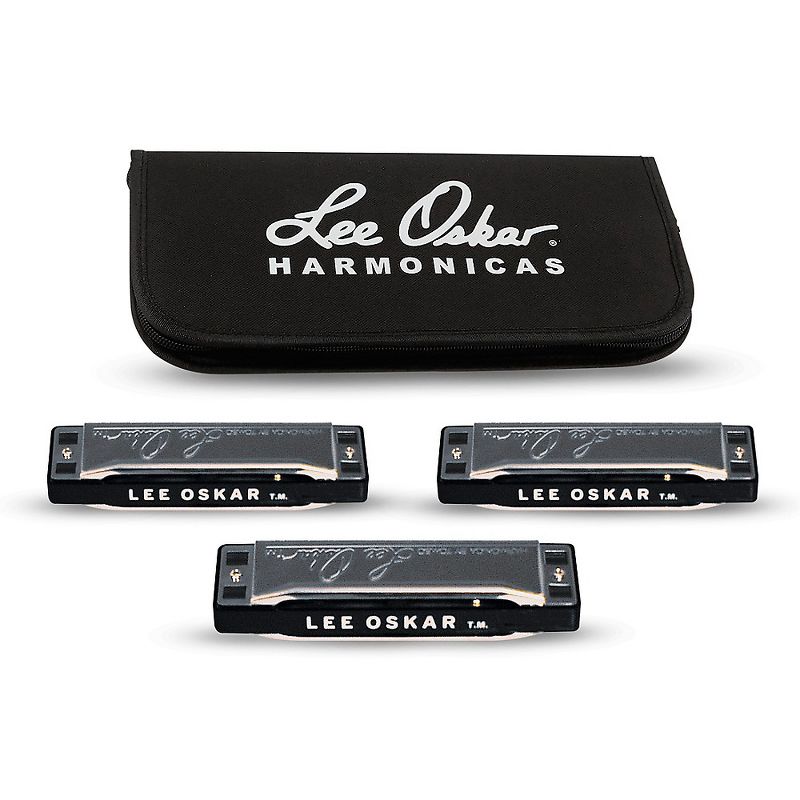Lee Oskar Harmonic Minor Reed Plates F# MINOR
No need to toss that harp with bad reeds. Simply replace the reed plate and save yourself some hard-earned money. Installs easily in minutes.
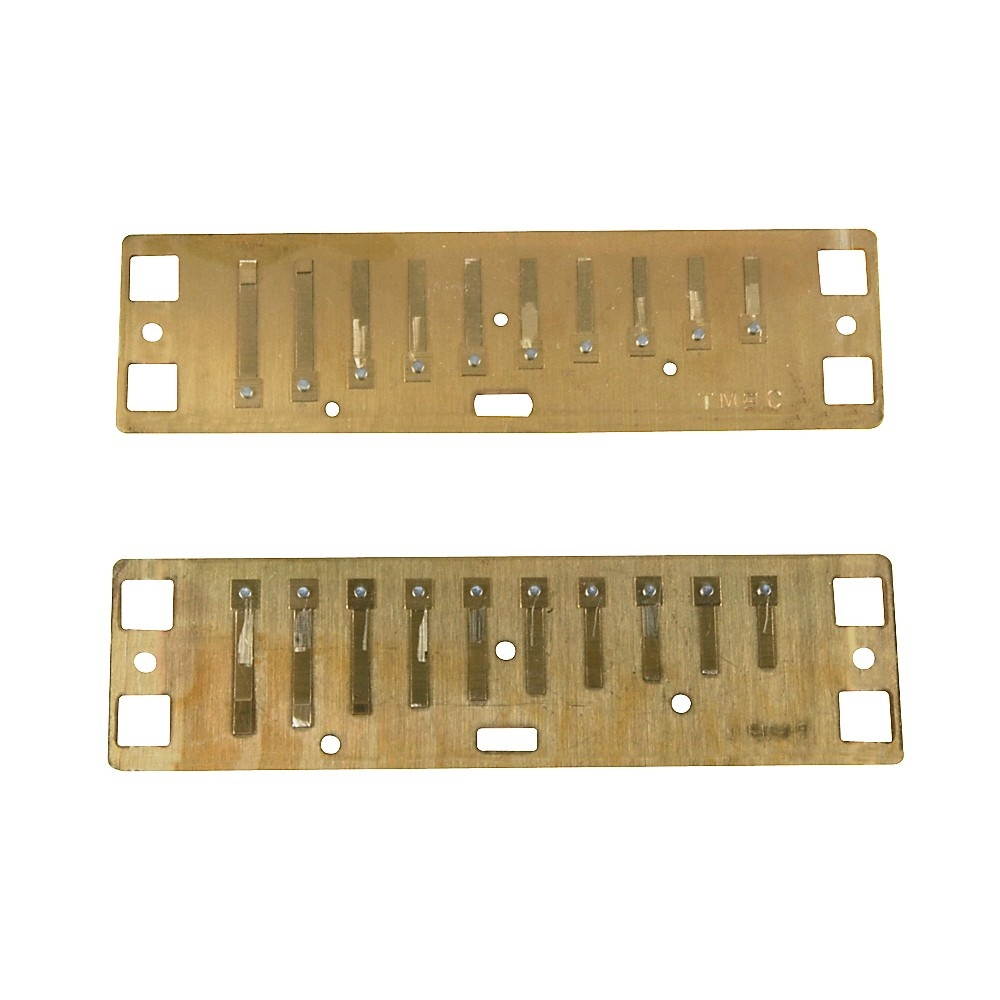
Genuine New Lee Oskar 1910 Natural Minor Harmonica or Harp. Key of E Flat Minor
Genuine New Lee Oskar 1910 Natural Minor Harmonica or Harp. Key of E Flat Minor condition: New Brand: Lee OskarMPN: 1910NEF-UKey: EbmType: Natural MinorCountry/Region of Manufacture: JapanCode : 397-238479000112455

Lee Oskar Major Diatonic Harmonica, Key of B
The Major Diatonic harmonica is the most commonly used tuning for playing Blues, Rock, Country Folk & Jazz. Major Diatonic harps are produced by several manufacturers using various names such as Blues Harp, Marine Band, Golden Melody, Big River, Special 20, Pro Harp, Folk Master, Star Performer, etc. Although the cover plates are stamped with a variety of different names for marketing purposes, all of these harmonicas have the exact same notation layout as the Lee Oskar Major Diatonic. The most important difference is in the quality of materials, construction, design and sound. Lee Oskars are the best harmonicas in the world, and that's not just our opinion. All over the world, professional players prefer Lee Oskar Harps over any other brand.
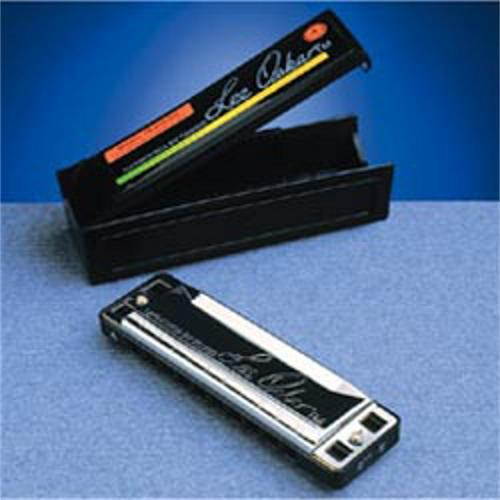
Lee Oskar Natural Minor Harmonica, Key of B
Natural Minor harps have a very bluesy, soulful sound that's perfect for playing MINOR Blues, Rock, Country, Reggae, Pop & Jazz. This fabulous tuning is set up to play MINOR MUSIC easily, without straining the lips, the lungs or the mind! All of the notes and chords that were missing on the Major Diatonic, for playing minor blues, are right there on the Natural Minor. Natural Minors are designed to be played in cross harp (draw), not straight harp (blow). In cross harp, many of the draw notes can be bent and this allows for a much more expressive, fluid style of playing. Cross harp is a very popular style used by most players for today's music.
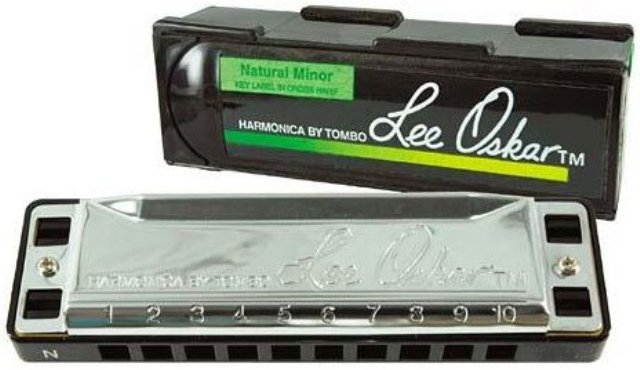
Lee Oskar Major Diatonic Harmonica, Key of Eb
Well-suited for blues, rock, country, folk, and jazz. They're more airtight, easier to bend, and better sounding than many harps. Modular design. Built in Japan to his exacting standards and incorporating new techniques and materials, it was in 1983 that Lee Oskar introduced his new harmonica. The radically different harp design grew out of Lee's frustration with the lack of quality and consistency in the mouth harps of the day. The design also benefited from Oskar's insights as a seasoned recording and touring pro. The Dane's DesignCentral to Oskar's design is a smooth plastic comb that doesn't swell like traditional wood combs. Aside from being easier to keep clean, the plastic comb is impervious to the swelling of conventional harmonica wood combs that can tear up the player's lips. By making affordable replacement reed plates available, Oskar's harps can be easily refurbished. You no longer need to toss out a harmonica because a reed or two has gone south. Replacement reed plates are available for every model in the Lee Oskar harmonica lineup and installation is easy since they mount to the comb with just three self-tapping screws. The reed plates have wide chambers and narrow dividers for faster, easier playing. A precision-molded, recessed bed holds the reed plate securely to prevent air leakage and project a bigger sound. The corrosion-proof, stainless steel cover plates are also engineered for excellent projection and tone. (Replacement cover plates are also available. ) Lee Oskar harmonicas are tuned to 441-plus hertz for a brighter sound. With equal tuning by octaves, Lee Oskar harps have excellent intonation for blowing highly articulate, single-note leads. More Keys and ModesLee's innovation didn't stop with a better-designed harp. Recognizing the need for harmonicas tuned in other than the major and natural minor diatonic scales, he introduced the Melody Maker and Harmonic Minor series that make it easier to play melodies difficult if not impossible to play with a standard diatonic harmonica. Another indication of Oskar's hard-won knowledge as a touring pro: Each harp is clearly marked in bright white on both ends with its first- and second-position (straight and cross-harp) keys. Each harmonica box is color-coded according to its series and also displays its key prominently. If you've ever struggled to find the right harp on a darkened stage, you will appreciate this simple yet essential touch. About Lee OskarEven if you don't recognize Lee Oskar by name, if you've listened to pop radio much, you've probably heard his highly personal mouth harp style on War hits like "The Cisco Kid, " "Low Rider, " and "Why Can't We Be Friends. " Oskar's staccato phrasing and uncanny tone-put to great use blowing horn-like unison riffs with saxman Charles Miller-gave War's funky stew of Latino, Caribbean, African, jazz, rock, and R & B elements a distinctive lead voice. This was especially true after the departure of vocalist Eric Burdon. The former Animals singer had been a focal point for War on early hits like "Spill The Wine. " The band's eclectic and fluent mix of genres proved a rich fount leading to a string of '70s and '80s hits, usually with Oskar's distinctive harp riffs providing the signature sound.

Lee Oskar Natural Minor Harmonica G MINOR
Natural Minor harps have a very bluesy, soulful sound that's perfect for playing blues, rock, country, reggae, pop, and jazz. This fabulous tuning is set up to play tunes in minor keys easily without straining the lips, the lungs, or the mind! All of the notes and chords that are missing on major diatonic harps are right there on the Natural Minor. Natural Minors are designed to be played in cross harp (draw), not straight harp (blow) position. In cross harp, many of the draw notes can be bent and this allows for a much more expressive, fluid style of playing. Cross harp is a very popular style used by most players for today's music. Built in Japan to his exacting standards and incorporating new techniques and materials, it was in 1983 that Lee Oskar introduced his new harmonica. The radically different harp design grew out of Lee's frustration with the lack of quality and consistency in the mouth harps of the day. The design also benefited from Oskar's insights as a seasoned recording and touring pro. The Dane's DesignCentral to Oskar's design is a smooth plastic comb that doesn't swell like traditional wood combs. Aside from being easier to keep clean, the plastic comb is impervious to the swelling of conventional harmonica wood combs that can tear up the player's lips. By making affordable replacement reed plates available, Oskar's harps can be easily refurbished. You no longer need to toss out a harmonica because a reed or two has gone south. Replacement reed plates are available for every model in the Lee Oskar harmonica lineup and installation is easy since they mount to the comb with just three self-tapping screws. The reed plates have wide chambers and narrow dividers for faster, easier playing. A precision-molded, recessed bed holds the reed plate securely to prevent air leakage and project a bigger sound. The corrosion-proof, stainless steel cover plates are also engineered for excellent projection and tone. (Replacement cover plates are also available. ) Lee Oskar harmonicas are tuned to 441-plus hertz for a brighter sound. With equal tuning by octaves, Lee Oskar harps have excellent intonation for blowing highly articulate, single-note leads. More Keys and Modesbr>Lee's innovation didn't stop with a better-designed harp. Recognizing the need for harmonicas tuned in other than the major and natural minor diatonic scales, he introduced the Melody Maker and Harmonic Minor series that make it easier to play melodies difficult if not impossible to play with a standard diatonic harmonica. Another indication of Oskar's hard-won knowledge as a touring pro: Each harp is clearly marked in bright white on both ends with its first- and second-position (straight and cross-harp) keys. Each harmonica box is color-coded according to its series and also displays its key prominently. If you've ever struggled to find the right harp on a darkened stage, you will appreciate this simple yet essential touch. About Lee OskarEven if you don't recognize Lee Oskar by name, if you've listened to pop radio much, you've probably heard his highly personal mouth harp style on War hits like "The Cisco Kid, " "Low Rider, " and "Why Can't We Be Friends. " Oskar's staccato phrasing and uncanny tone-put to great use blowing horn-like unison riffs with saxman Charles Miller-gave War's funky stew of Latino, Caribbean, African, jazz, rock, and R & B elements a distinctive lead voice. This was especially true after the departure of vocalist Eric Burdon. The former Animals singer had been a focal point for War on early hits like "Spill The Wine. " The band's eclectic and fluent mix of genres proved a rich fount leading to a string of '70s and '80s hits, usually with Oskar's distinctive harp riffs providing the signature sound.
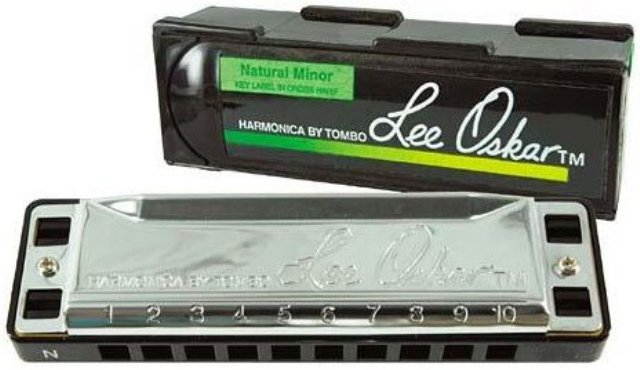
Genuine New Lee Oskar 1910 Natural Minor Harmonica or Harp. Key of D Flat Minor
Genuine New Lee Oskar 1910 Natural Minor Harmonica or Harp. Key of D Flat Minor condition: New Brand: Lee OskarMPN: 1910NDF-UKey: DbmType: Natural MinorCountry/Region of Manufacture: JapanCode : d18-239564000292002
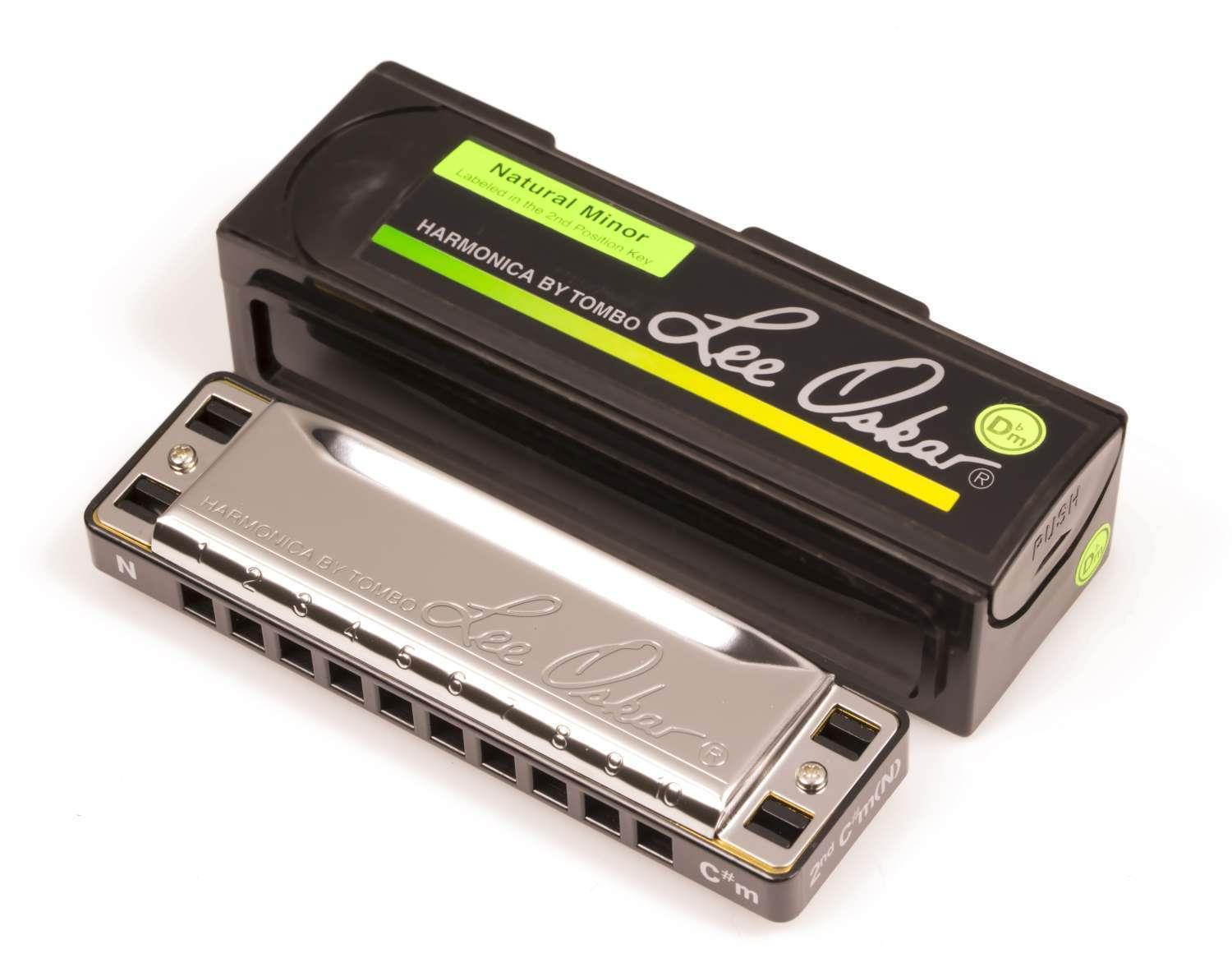
Lee Oskar Melody Maker Harmonica, Key of C
Melody Makers are the best harps available for playing single-note melodies. They're great for playing country, pop, R & B, jazz, folk, & standards. This tuning makes it easier to play many songs... that can be difficult, or impossible, to play on a standard major diatonic... in cross harp. All of the notes that are missing on the major diatonic are right there on the Melody Maker! It provides a complete major scale in cross harp for playing exact melody without bending. Yet, the draw notes can still be bent for that bluesy feeling! Melody Makers are designed to be played in cross harp (draw), not straight harp (blow). In cross harp, melodies can be played with an expressive, fluid style that is extremely difficult to achieve in straight harp. Built in Japan to his exacting standards and incorporating new techniques and materials, it was in 1983 that Lee Oskar introduced his new harmonica. The radically different harp design grew out of Lee's frustration with the lack of quality and consistency in the mouth harps of the day. The design also benefited from Oskar's insights as a seasoned recording and touring pro. The Dane's DesignCentral to Oskar's design is a smooth plastic comb that doesn't swell like traditional wood combs. Aside from being easier to keep clean, the plastic comb is impervious to the swelling of conventional harmonica wood combs that can tear up the player's lips. By making affordable replacement reed plates available, Oskar's harps can be easily refurbished. You no longer need to toss out a harmonica because a reed or two has gone south. Replacement reed plates are available for every model in the Lee Oskar harmonica lineup and installation is easy since they mount to the comb with just three self-tapping screws. The reed plates have wide chambers and narrow dividers for faster, easier playing. A precision-molded, recessed bed holds the reed plate securely to prevent air leakage and project a bigger sound. The corrosion-proof, stainless steel cover plates are also engineered for excellent projection and tone. (Replacement cover plates are also available. ) Lee Oskar harmonicas are tuned to 441-plus hertz for a brighter sound. With equal tuning by octaves, Lee Oskar harps have excellent intonation for blowing highly articulate, single-note leads. More Keys and ModesLee's innovation didn't stop with a better-designed harp. Recognizing the need for harmonicas tuned in other than the major and natural minor diatonic scales, he introduced the Melody Maker and Harmonic Minor series that make it easier to play melodies difficult if not impossible to play with a standard diatonic harmonica. Another indication of Oskar's hard-won knowledge as a touring pro: Each harp is clearly marked in bright white on both ends with its first- and second-position (straight and cross-harp) keys. Each harmonica box is color-coded according to its series and also displays its key prominently. If you've ever struggled to find the right harp on a darkened stage, you will appreciate this simple yet essential touch. About Lee OskarEven if you don't recognize Lee Oskar by name, if you've listened to pop radio much, you've probably heard his highly personal mouth harp style on War hits like "The Cisco Kid, " "Low Rider, " and "Why Can't We Be Friends. " Oskar's staccato phrasing and uncanny tone-put to great use blowing horn-like unison riffs with saxman Charles Miller-gave War's funky stew of Latino, Caribbean, African, jazz, rock, and R & B elements a distinctive lead voice. This was especially true after the departure of vocalist Eric Burdon. The former Animals singer had been a focal point for War on early hits like "Spill The Wine. " The band's eclectic and fluent mix of genres proved a rich fount leading to a string of '70s and '80s hits, usually with Oskar's distinctive harp riffs providing the signature sound.
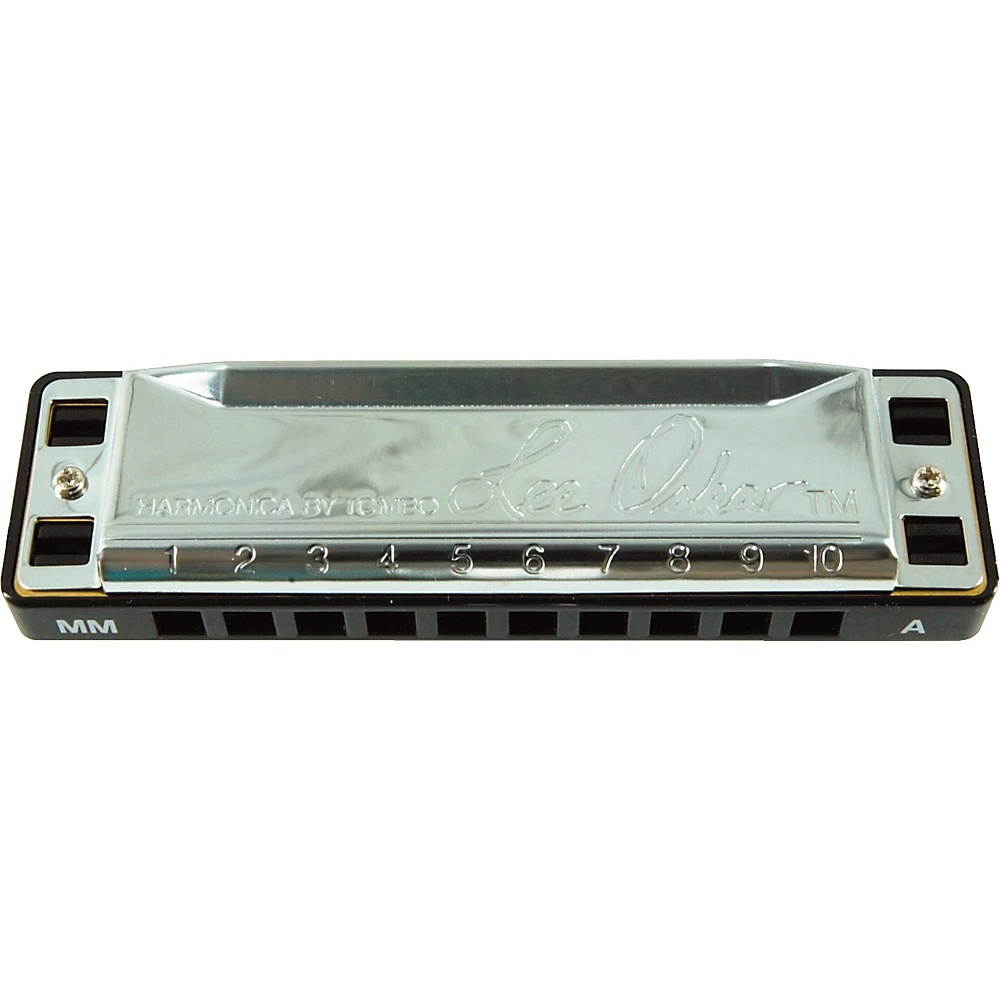
L.Oskar Reed Plates Maj D
L.Oskar Reed Plates Maj D

L.Oskar Reed Plates N/Mn A
L.Oskar Reed Plates N/Mn A

L.Oskar Reed Plates Maj G
L.Oskar Reed Plates Maj G
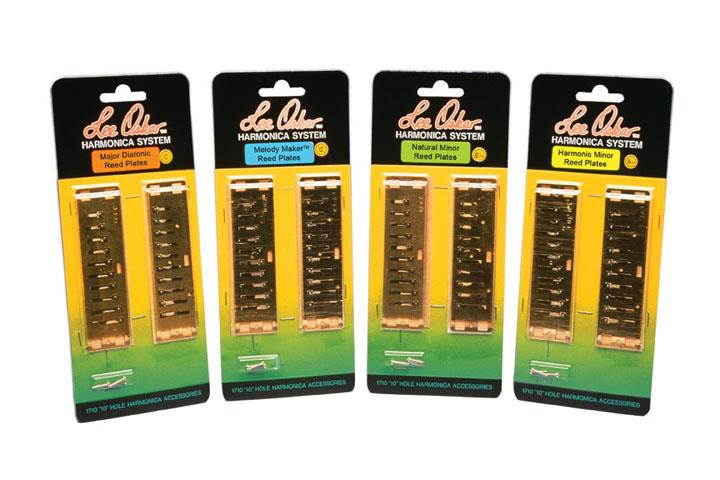
L.Oskar Reed Plates Maj A
L.Oskar Reed Plates Maj A
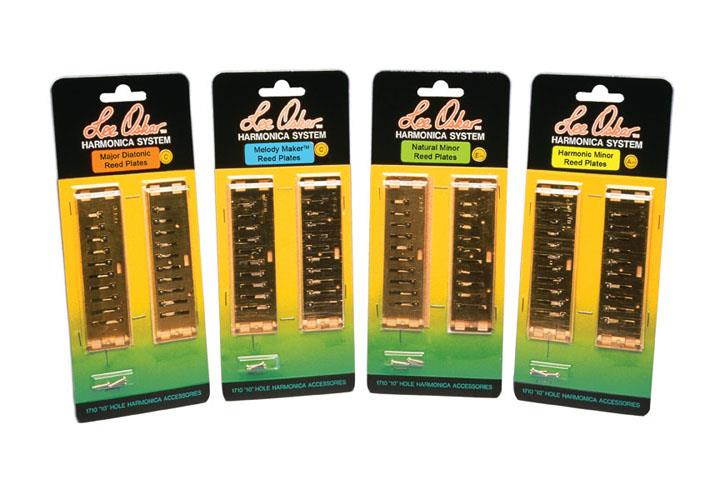
Lee Oskar Natural Minor Harmonica, Key of Ab
Natural Minor harps have a very bluesy, soulful sound that's perfect for playing blues, rock, country, reggae, pop, and jazz. This fabulous tuning is set up to play tunes in minor keys easily without straining the lips, the lungs, or the mind! All of the notes and chords that are missing on major diatonic harps are right there on the Natural Minor. Natural Minors are designed to be played in cross harp (draw), not straight harp (blow) position. In cross harp, many of the draw notes can be bent and this allows for a much more expressive, fluid style of playing. Cross harp is a very popular style used by most players for today's music. Built in Japan to his exacting standards and incorporating new techniques and materials, it was in 1983 that Lee Oskar introduced his new harmonica. The radically different harp design grew out of Lee's frustration with the lack of quality and consistency in the mouth harps of the day. The design also benefited from Oskar's insights as a seasoned recording and touring pro. The Dane's DesignCentral to Oskar's design is a smooth plastic comb that doesn't swell like traditional wood combs. Aside from being easier to keep clean, the plastic comb is impervious to the swelling of conventional harmonica wood combs that can tear up the player's lips. By making affordable replacement reed plates available, Oskar's harps can be easily refurbished. You no longer need to toss out a harmonica because a reed or two has gone south. Replacement reed plates are available for every model in the Lee Oskar harmonica lineup and installation is easy since they mount to the comb with just three self-tapping screws. The reed plates have wide chambers and narrow dividers for faster, easier playing. A precision-molded, recessed bed holds the reed plate securely to prevent air leakage and project a bigger sound. The corrosion-proof, stainless steel cover plates are also engineered for excellent projection and tone. (Replacement cover plates are also available. ) Lee Oskar harmonicas are tuned to 441-plus hertz for a brighter sound. With equal tuning by octaves, Lee Oskar harps have excellent intonation for blowing highly articulate, single-note leads. More Keys and Modesbr>Lee's innovation didn't stop with a better-designed harp. Recognizing the need for harmonicas tuned in other than the major and natural minor diatonic scales, he introduced the Melody Maker and Harmonic Minor series that make it easier to play melodies difficult if not impossible to play with a standard diatonic harmonica. Another indication of Oskar's hard-won knowledge as a touring pro: Each harp is clearly marked in bright white on both ends with its first- and second-position (straight and cross-harp) keys. Each harmonica box is color-coded according to its series and also displays its key prominently. If you've ever struggled to find the right harp on a darkened stage, you will appreciate this simple yet essential touch. About Lee OskarEven if you don't recognize Lee Oskar by name, if you've listened to pop radio much, you've probably heard his highly personal mouth harp style on War hits like "The Cisco Kid, " "Low Rider, " and "Why Can't We Be Friends. " Oskar's staccato phrasing and uncanny tone-put to great use blowing horn-like unison riffs with saxman Charles Miller-gave War's funky stew of Latino, Caribbean, African, jazz, rock, and R & B elements a distinctive lead voice. This was especially true after the departure of vocalist Eric Burdon. The former Animals singer had been a focal point for War on early hits like "Spill The Wine. " The band's eclectic and fluent mix of genres proved a rich fount leading to a string of '70s and '80s hits, usually with Oskar's distinctive harp riffs providing the signature sound.

Lee Oskar Melody Maker Harmonica - Key of A
Lee Oskar Melody Maker Harmonica - Key of A condition: New Brand: Lee Oskar MPN: 1910MMA-U

Lee Oskar Major Diatonic Harmonica, Key of F#
The Major Diatonic harmonica is the most commonly used tuning for playing Blues, Rock, Country Folk & Jazz. Major Diatonic harps are produced by several manufacturers using various names such as Blues Harp, Marine Band, Golden Melody, Big River, Special 20, Pro Harp, Folk Master, Star Performer, etc. Although the cover plates are stamped with a variety of different names for marketing purposes, all of these harmonicas have the exact same notation layout as the Lee Oskar Major Diatonic. The most important difference is in the quality of materials, construction, design and sound. Lee Oskars are the best harmonicas in the world, and that's not just our opinion. All over the world, professional players prefer Lee Oskar Harps over any other brand.

Lee Oskar 10 Hole Harmonica Holder
The Lee Oskar Harmonica Holder is specially designed for 10-hole harmonicas. Adjustable, fits securely around the neck. All-metal construction.
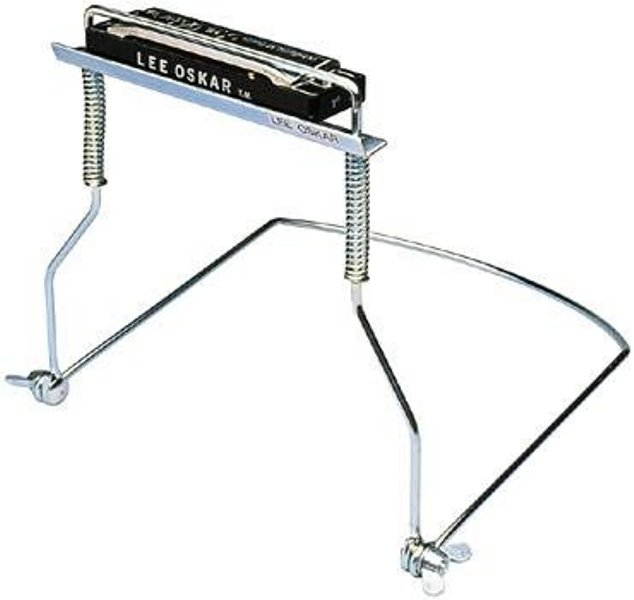
Genuine New Lee Oskar 1910 Major Diatonic Harmonica or Harp. Key of B
Genuine New Lee Oskar 1910 Major Diatonic Harmonica or Harp. Key of B condition: New Brand: Lee OskarMPN: 1910B-UKey: BType: DiatonicCountry/Region of Manufacture: JapanCode : 097-207933000292002

Lee Oskar Mini Harmonica Keychain
Mini 4-hole with key chain. Key of C.
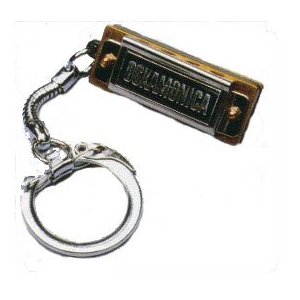
Lee Oskar Natural Minor Harmonica, Key of F#
Natural Minor harps have a very bluesy, soulful sound that's perfect for playing MINOR Blues, Rock, Country, Reggae, Pop & Jazz. This fabulous tuning is set up to play MINOR MUSIC easily, without straining the lips, the lungs or the mind! All of the notes and chords that were missing on the Major Diatonic, for playing minor blues, are right there on the Natural Minor. Natural Minors are designed to be played in cross harp (draw), not straight harp (blow). In cross harp, many of the draw notes can be bent and this allows for a much more expressive, fluid style of playing. Cross harp is a very popular style used by most players for today's music.
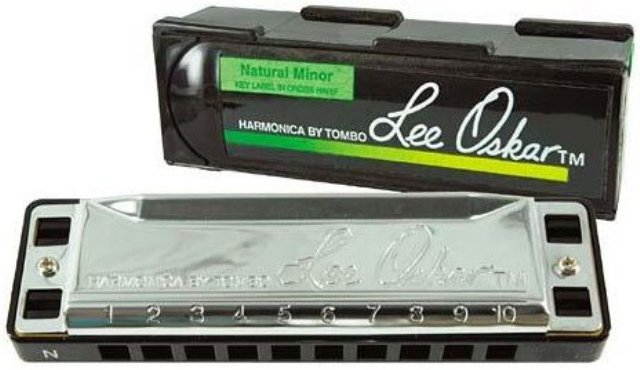
Lee Oskar Major Diatonic Harmonica, Key of E
The Major Diatonic harmonica is the most commonly used tuning for playing Blues, Rock, Country Folk & Jazz. Major Diatonic harps are produced by several manufacturers using various names such as Blues Harp, Marine Band, Golden Melody, Big River, Special 20, Pro Harp, Folk Master, Star Performer, etc. Although the cover plates are stamped with a variety of different names for marketing purposes, all of these harmonicas have the exact same notation layout as the Lee Oskar Major Diatonic. The most important difference is in the quality of materials, construction, design and sound. Lee Oskars are the best harmonicas in the world, and that's not just our opinion. All over the world, professional players prefer Lee Oskar Harps over any other brand.

Lee Oskar Major Diatonic Harmonica, Key of A
Commonly used tunings. Well-suited for blues, rock, country, folk, and jazz. They're more airtight, easier to bend, and better sounding than many harps.

Lee Oskar Major Diatonic Harmonica, Key of C
Well-suited for blues, rock, country, folk, and jazz. They're more airtight, easier to bend, and better sounding than many harps. Modular design. Built in Japan to his exacting standards and incorporating new techniques and materials, it was in 1983 that Lee Oskar introduced his new harmonica. The radically different harp design grew out of Lee's frustration with the lack of quality and consistency in the mouth harps of the day. The design also benefited from Oskar's insights as a seasoned recording and touring pro. The Dane's DesignCentral to Oskar's design is a smooth plastic comb that doesn't swell like traditional wood combs. Aside from being easier to keep clean, the plastic comb is impervious to the swelling of conventional harmonica wood combs that can tear up the player's lips. By making affordable replacement reed plates available, Oskar's harps can be easily refurbished. You no longer need to toss out a harmonica because a reed or two has gone south. Replacement reed plates are available for every model in the Lee Oskar harmonica lineup and installation is easy since they mount to the comb with just three self-tapping screws. The reed plates have wide chambers and narrow dividers for faster, easier playing. A precision-molded, recessed bed holds the reed plate securely to prevent air leakage and project a bigger sound. The corrosion-proof, stainless steel cover plates are also engineered for excellent projection and tone. (Replacement cover plates are also available. ) Lee Oskar harmonicas are tuned to 441-plus hertz for a brighter sound. With equal tuning by octaves, Lee Oskar harps have excellent intonation for blowing highly articulate, single-note leads. More Keys and ModesLee's innovation didn't stop with a better-designed harp. Recognizing the need for harmonicas tuned in other than the major and natural minor diatonic scales, he introduced the Melody Maker and Harmonic Minor series that make it easier to play melodies difficult if not impossible to play with a standard diatonic harmonica. Another indication of Oskar's hard-won knowledge as a touring pro: Each harp is clearly marked in bright white on both ends with its first- and second-position (straight and cross-harp) keys. Each harmonica box is color-coded according to its series and also displays its key prominently. If you've ever struggled to find the right harp on a darkened stage, you will appreciate this simple yet essential touch. About Lee OskarEven if you don't recognize Lee Oskar by name, if you've listened to pop radio much, you've probably heard his highly personal mouth harp style on War hits like "The Cisco Kid, " "Low Rider, " and "Why Can't We Be Friends. " Oskar's staccato phrasing and uncanny tone-put to great use blowing horn-like unison riffs with saxman Charles Miller-gave War's funky stew of Latino, Caribbean, African, jazz, rock, and R & B elements a distinctive lead voice. This was especially true after the departure of vocalist Eric Burdon. The former Animals singer had been a focal point for War on early hits like "Spill The Wine. " The band's eclectic and fluent mix of genres proved a rich fount leading to a string of '70s and '80s hits, usually with Oskar's distinctive harp riffs providing the signature sound.
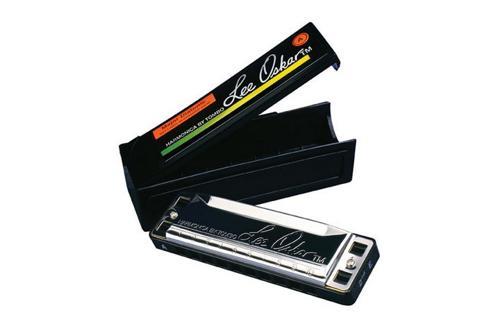
Lee Oskar Major Diatonic Harmonica, Key of F
Well-suited for blues, rock, country, folk, and jazz. They're more airtight, easier to bend, and better sounding than many harps. Modular design. Built in Japan to his exacting standards and incorporating new techniques and materials, it was in 1983 that Lee Oskar introduced his new harmonica. The radically different harp design grew out of Lee's frustration with the lack of quality and consistency in the mouth harps of the day. The design also benefited from Oskar's insights as a seasoned recording and touring pro. The Dane's DesignCentral to Oskar's design is a smooth plastic comb that doesn't swell like traditional wood combs. Aside from being easier to keep clean, the plastic comb is impervious to the swelling of conventional harmonica wood combs that can tear up the player's lips. By making affordable replacement reed plates available, Oskar's harps can be easily refurbished. You no longer need to toss out a harmonica because a reed or two has gone south. Replacement reed plates are available for every model in the Lee Oskar harmonica lineup and installation is easy since they mount to the comb with just three self-tapping screws. The reed plates have wide chambers and narrow dividers for faster, easier playing. A precision-molded, recessed bed holds the reed plate securely to prevent air leakage and project a bigger sound. The corrosion-proof, stainless steel cover plates are also engineered for excellent projection and tone. (Replacement cover plates are also available. ) Lee Oskar harmonicas are tuned to 441-plus hertz for a brighter sound. With equal tuning by octaves, Lee Oskar harps have excellent intonation for blowing highly articulate, single-note leads. More Keys and ModesLee's innovation didn't stop with a better-designed harp. Recognizing the need for harmonicas tuned in other than the major and natural minor diatonic scales, he introduced the Melody Maker and Harmonic Minor series that make it easier to play melodies difficult if not impossible to play with a standard diatonic harmonica. Another indication of Oskar's hard-won knowledge as a touring pro: Each harp is clearly marked in bright white on both ends with its first- and second-position (straight and cross-harp) keys. Each harmonica box is color-coded according to its series and also displays its key prominently. If you've ever struggled to find the right harp on a darkened stage, you will appreciate this simple yet essential touch. About Lee OskarEven if you don't recognize Lee Oskar by name, if you've listened to pop radio much, you've probably heard his highly personal mouth harp style on War hits like "The Cisco Kid, " "Low Rider, " and "Why Can't We Be Friends. " Oskar's staccato phrasing and uncanny tone-put to great use blowing horn-like unison riffs with saxman Charles Miller-gave War's funky stew of Latino, Caribbean, African, jazz, rock, and R & B elements a distinctive lead voice. This was especially true after the departure of vocalist Eric Burdon. The former Animals singer had been a focal point for War on early hits like "Spill The Wine. " The band's eclectic and fluent mix of genres proved a rich fount leading to a string of '70s and '80s hits, usually with Oskar's distinctive harp riffs providing the signature sound.

Genuine New Lee Oskar 1910 Harmonica Harp Reed Plates Diatonic Major Key of F
Genuine New Lee Oskar 1910 Harmonica Harp Reed Plates Diatonic Major Key of F condition: New Brand: Lee OskarMPN: 1910RPF-UKey: FType: DiatonicCountry/Region of Manufacture: JapanCode : 4ca-476561000302552
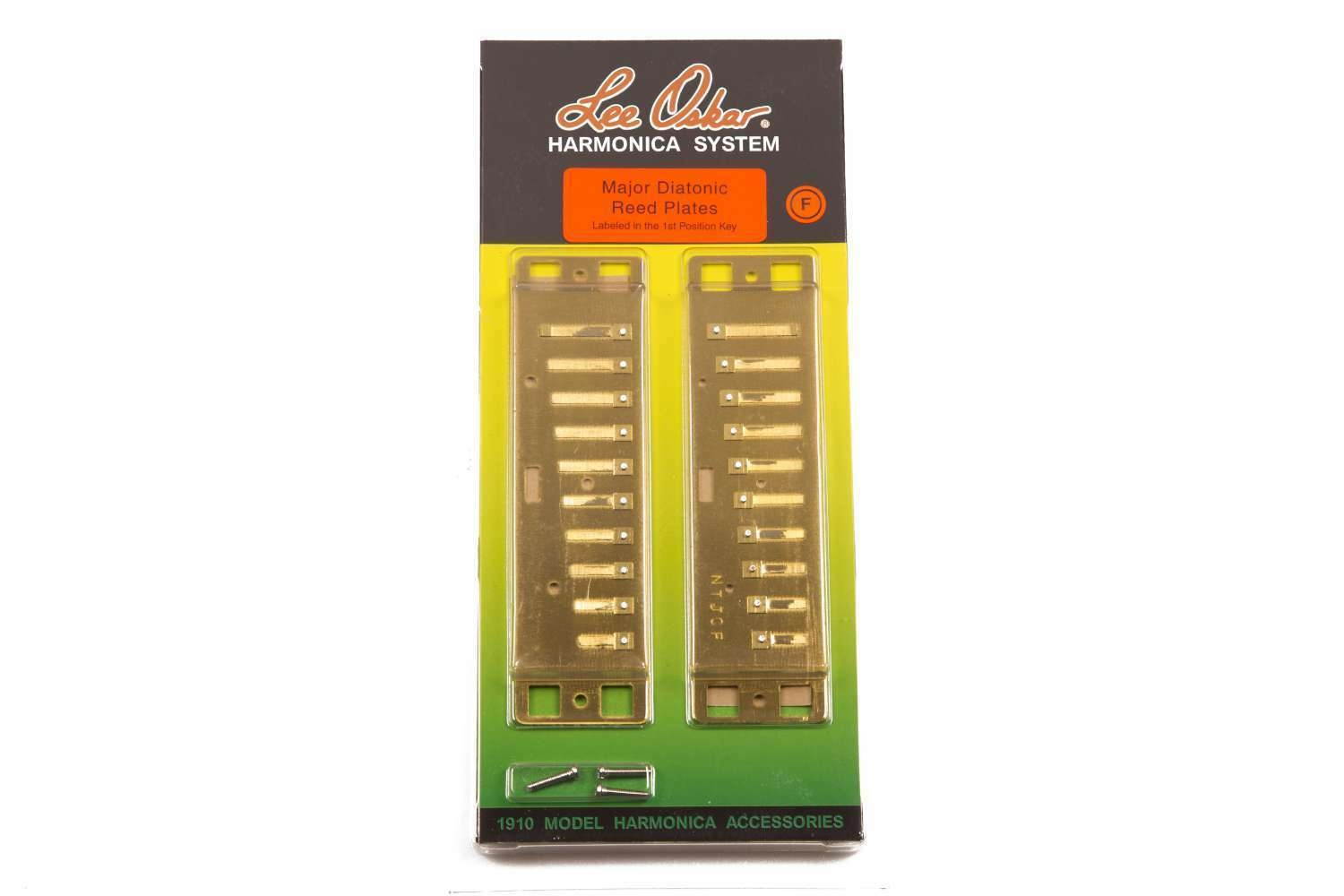
Lee Oskar Major Diatonic Harmonica, Key of Db
The Major Diatonic harmonica is the most commonly used tuning for playing Blues, Rock, Country Folk & Jazz. Major Diatonic harps are produced by several manufacturers using various names such as Blues Harp, Marine Band, Golden Melody, Big River, Special 20, Pro Harp, Folk Master, Star Performer, etc. Although the cover plates are stamped with a variety of different names for marketing purposes, all of these harmonicas have the exact same notation layout as the Lee Oskar Major Diatonic. The most important difference is in the quality of materials, construction, design and sound. Lee Oskars are the best harmonicas in the world, and that's not just our opinion. All over the world, professional players prefer Lee Oskar Harps over any other brand.

Genuine New Lee Oskar 1910 Harmonica Major Key F Sharp
Genuine New Lee Oskar 1910 Harmonica Major Key F Sharp condition: New Brand: Lee OskarCountry/Region of Manufacture: JapanKey: F#MPN: LE-1910FS-UType: Diatonic
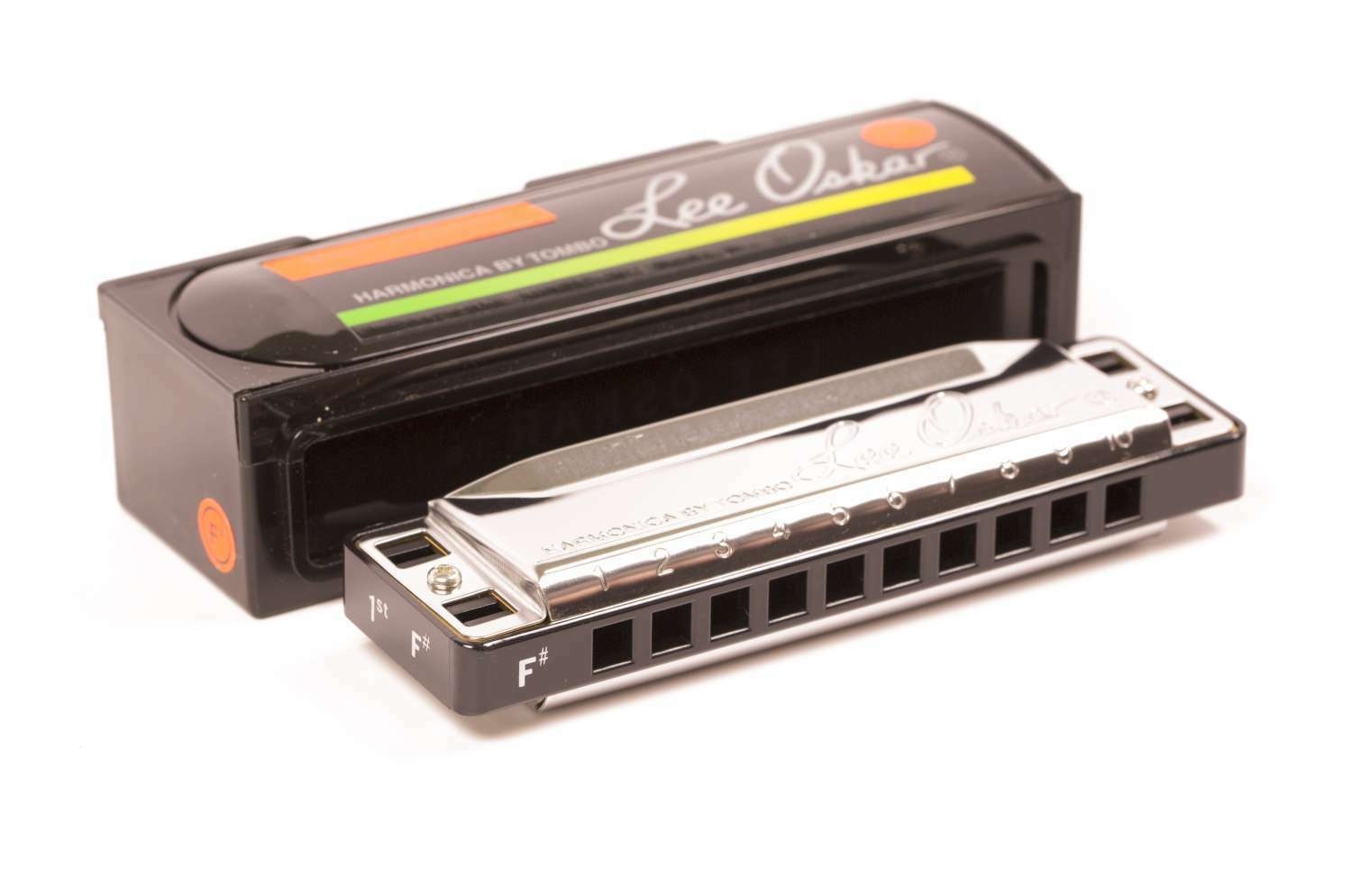
Lee Oskar Major Diatonic Harmonica, Key of G
Commonly used tunings. Well-suited for blues, rock, country, folk, and jazz. They're more airtight, easier to bend, and better sounding than many harps.

Lee Oskar Natural Minor Harmonica, Key of C
Natural Minor harps have a very bluesy, soulful sound that's perfect for playing blues, rock, country, reggae, pop, and jazz. This fabulous tuning is set up to play tunes in minor keys easily without straining the lips, the lungs, or the mind! All of the notes and chords that are missing on major diatonic harps are right there on the Natural Minor. Natural Minors are designed to be played in cross harp (draw), not straight harp (blow) position. In cross harp, many of the draw notes can be bent and this allows for a much more expressive, fluid style of playing. Cross harp is a very popular style used by most players for today's music. Built in Japan to his exacting standards and incorporating new techniques and materials, it was in 1983 that Lee Oskar introduced his new harmonica. The radically different harp design grew out of Lee's frustration with the lack of quality and consistency in the mouth harps of the day. The design also benefited from Oskar's insights as a seasoned recording and touring pro. The Dane's DesignCentral to Oskar's design is a smooth plastic comb that doesn't swell like traditional wood combs. Aside from being easier to keep clean, the plastic comb is impervious to the swelling of conventional harmonica wood combs that can tear up the player's lips. By making affordable replacement reed plates available, Oskar's harps can be easily refurbished. You no longer need to toss out a harmonica because a reed or two has gone south. Replacement reed plates are available for every model in the Lee Oskar harmonica lineup and installation is easy since they mount to the comb with just three self-tapping screws. The reed plates have wide chambers and narrow dividers for faster, easier playing. A precision-molded, recessed bed holds the reed plate securely to prevent air leakage and project a bigger sound. The corrosion-proof, stainless steel cover plates are also engineered for excellent projection and tone. (Replacement cover plates are also available. ) Lee Oskar harmonicas are tuned to 441-plus hertz for a brighter sound. With equal tuning by octaves, Lee Oskar harps have excellent intonation for blowing highly articulate, single-note leads. More Keys and Modesbr>Lee's innovation didn't stop with a better-designed harp. Recognizing the need for harmonicas tuned in other than the major and natural minor diatonic scales, he introduced the Melody Maker and Harmonic Minor series that make it easier to play melodies difficult if not impossible to play with a standard diatonic harmonica. Another indication of Oskar's hard-won knowledge as a touring pro: Each harp is clearly marked in bright white on both ends with its first- and second-position (straight and cross-harp) keys. Each harmonica box is color-coded according to its series and also displays its key prominently. If you've ever struggled to find the right harp on a darkened stage, you will appreciate this simple yet essential touch. About Lee OskarEven if you don't recognize Lee Oskar by name, if you've listened to pop radio much, you've probably heard his highly personal mouth harp style on War hits like "The Cisco Kid, " "Low Rider, " and "Why Can't We Be Friends. " Oskar's staccato phrasing and uncanny tone-put to great use blowing horn-like unison riffs with saxman Charles Miller-gave War's funky stew of Latino, Caribbean, African, jazz, rock, and R & B elements a distinctive lead voice. This was especially true after the departure of vocalist Eric Burdon. The former Animals singer had been a focal point for War on early hits like "Spill The Wine. " The band's eclectic and fluent mix of genres proved a rich fount leading to a string of '70s and '80s hits, usually with Oskar's distinctive harp riffs providing the signature sound.
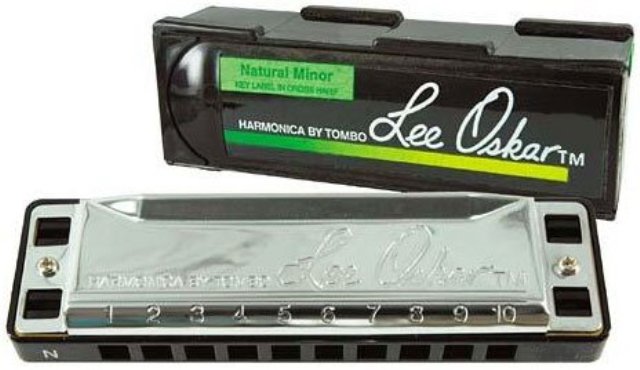
Lee Oskar Harmonica 5-Pack with Case
Dimensions (Overall): 1.0 inches (L), 1.0 inches (H) x 1.0 inches (W)Weight: 5.5 poundsKey (tuned): Not Key SpecificWarranty: No Applicable Warranty. To obtain a copy of the manufacturer's or supplier's warranty for this item prior to purchasing the item, & bull; Harmonica Features & bull; Airtight & bull; Easier second-position bending & bull; All key components are replaceable & bull; Durable and longer-lasting than other harpsIncludes 5 Lee Oskar Major Diatonic Harmonicas (keys of G, A, C, D, and F - lowest to highest) and a hardshell harmonica case to carry them. The Major Diatonic Harmonicas are more airtight, easier to bend, and better sounding than most other harps. The hardshell harmonica case features a black Tolex cover, imitation leather accents with creme piping, a plush interior, and a locking latch under the handle. Holds 20 diatonic and 2 chromatic harmonicas. Removable tray, plenty of room for cables, microphone, and accessories. Built in Japan to his exacting standards and incorporating new techniques and materials, it was in 1983 that Lee Oskar introduced his new harmonica. The radically different harp design grew out of Lee's frustration with the lack of quality and consistency in the mouth harps of the day. The design also benefited from Oskar's insights as a seasoned recording and touring pro. The Dane's Design - Central to Oskar's design is a smooth plastic comb that doesn't swell like traditional wood combs. Aside from being easier to keep clean, the plastic comb is impervious to the swelling of conventional harmonica wood combs that can tear up the player's lips. By making affordable replacement reed plates available, Oskar's harps can be easily refurbished. no longer need to toss out a harmonica because a reed or two has gone south. Replacement reed plates are available for every model in the Lee Oskar harmonica lineup and installation is easy since they mount to the comb with just three self-tapping screws. The reed plates have wide chambers and narrow dividers for faster, easier playing. A precision-molded, recessed bed holds the reed plate securely to prevent air leakage and project a bigger sound. The corrosion-proof, stainless steel cover plates are also engineered for excellent projection and tone. (Replacement cover plates are also available.) Lee Oskar harmonicas are tuned to 441-plus hertz for a brighter sound. With equal tuning by octaves, Lee Oskar harps have excellent intonation for blowing highly articulate, single-note leads. More Keys and Modes - Lee's innovation didn't stop with a better-designed harp. Recognizing the need for harmonicas tuned in other than the major and natural minor diatonic scales, he introduced the Melody Maker and Harmonic Minor series that make it easier to play melodies difficult if not impossible to play with a standard diatonic harmonica. Another indication of Oskar's hard-won knowledge as a touring pro: Each harp is clearly marked in bright white on both ends with its first- and second-position (straight and cross-harp) keys. Each harmonica box is color-coded according to its series and also displays its key prominently. If 've ever struggled to find the right harp on a darkened stage, will appreciate this simple yet essential touch. About Lee Oskar - Even if don't recognize Lee Oskar by name, if 've listened to pop radio much, 've probably heard his highly personal mouth harp style on War hits like "The Cisco Kid," "Low Rider," and "Why Can't We Be Friends." Oskar's staccato phrasing and uncanny tone-put to great use blowing horn-like unison riffs with saxman Charles Miller-gave War's funky stew of Latino, Caribbean, African, jazz, rock, and R & B elements a distinctive lead voice. This was especially true after the departure of vocalist Eric Burdon. The former Animals singer had been a focal point for War on early hits like "Spill The Wine." The band's eclectic and fluent mix of genres proved a rich fount leading to a string of '70s and '80s hits, usually with Oskar's distinctive harp riffs providing the signature sound.

Lee Oskar Blues & Rock 'n Roll Pack with Soft Case - Keys A,C and D
Dimensions (Overall): 1.0 inches (L), 1.0 inches (H) x 1.0 inches (W)Weight: 1.0 poundsKey (tuned): Not Key SpecificWarranty: No Applicable Warranty. To obtain a copy of the manufacturer's or supplier's warranty for this item prior to purchasing the item, Well-suited for blues, rock, country, folk, and jazz. They're more airtight, easier to bend, and better sounding than many harps. Built in Japan to his exacting standards and incorporating new techniques and materials, it was in 1983 that Lee Oskar introduced his new harmonica. The radically different harp design grew out of Lee's frustration with the lack of quality and consistency in the mouth harps of the day. The design also benefited from Oskar's insights as a seasoned recording and touring pro. Central to Oskar's design is a smooth plastic comb that doesn't swell like traditional wood combs. Aside from being easier to keep clean, the plastic comb is impervious to the swelling of conventional harmonica wood combs that can tear up the player's lips. By making affordable replacement reed plates available, Oskar's harps can be easily refurbished. no longer need to toss out a harmonica because a reed or two has gone south. Replacement reed plates are available for every model in the Lee Oskar harmonica lineup and installation is easy since they mount to the comb with just three self-tapping screws. The reed plates have wide chambers and narrow dividers for faster, easier playing. A precision-molded, recessed bed holds the reed plate securely to prevent air leakage and project a bigger sound. The corrosion-proof, stainless steel cover plates are also engineered for excellent projection and tone. (Replacement cover plates are also available.) Lee Oskar harmonicas are tuned to 441-plus hertz for a brighter sound. With equal tuning by octaves, Lee Oskar harps have excellent intonation for blowing highly articulate, single-note leads.More Keys and ModesLee's innovation didn't stop with a better-designed harp. Recognizing the need for harmonicas tuned in other than the major and natural minor diatonic scales, he introduced the Melody Maker and Harmonic Minor series that make it easier to play melodies difficult if not impossible to play with a standard diatonic harmonica. Another indication of Oskar's hard-won knowledge as a touring pro: Each harp is clearly marked in bright white on both ends with its first- and second-position (straight and cross-harp) keys
